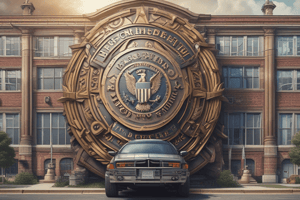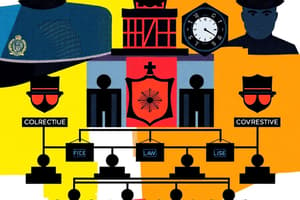Podcast
Questions and Answers
What is the primary responsibility of the Chief of Police/Sheriff?
What is the primary responsibility of the Chief of Police/Sheriff?
- Overall leadership and policy direction (correct)
- Enforcing traffic laws
- Managing patrol supervisors
- Conducting criminal investigations
Which division is primarily responsible for responding to incidents and community policing?
Which division is primarily responsible for responding to incidents and community policing?
- Special Operations
- Patrol Division (correct)
- Traffic Division
- Investigations Division
What function does the Investigations Division mainly perform?
What function does the Investigations Division mainly perform?
- Gathering evidence for emergencies
- Enforcing traffic laws
- Building community relationships
- Conducting follow-up investigations (correct)
What type of police organization operates in unincorporated areas and often manages jails?
What type of police organization operates in unincorporated areas and often manages jails?
Which of the following is NOT a function of police organizations?
Which of the following is NOT a function of police organizations?
Which concept promotes partnerships between police and community members?
Which concept promotes partnerships between police and community members?
What is a significant challenge faced by police organizations?
What is a significant challenge faced by police organizations?
Which division is responsible for enforcing traffic laws and investigating accidents?
Which division is responsible for enforcing traffic laws and investigating accidents?
Flashcards are hidden until you start studying
Study Notes
Overview of Police Organization
- Definition: Police organization refers to the structure, hierarchy, and operational framework of law enforcement agencies.
Structure of Police Organizations
-
Hierarchical Structure:
- Chief of Police/Sheriff: Top authority, responsible for overall leadership and policy direction.
- Deputy Chief/Undersheriff: Assists the chief, manages specific divisions or departments.
- Captains/Lieutenants: Oversee precincts or specialized units (e.g., criminal investigations, traffic).
- Sergeants: First-line supervisors, manage officers and ensure policies are followed.
- Patrol Officers/Detectives: Frontline personnel handling general law enforcement duties and investigations.
-
Divisional Structure:
- Patrol Division: Primary response unit for incidents and community policing.
- Investigations Division: Conducts follow-up investigations on crimes.
- Traffic Division: Enforces traffic laws and investigates accidents.
- Special Operations: Includes SWAT, K-9 units, and narcotics enforcement.
Types of Police Organizations
- Local Police Departments: Serve municipalities; handle community-based policing.
- County Sheriff's Offices: Operate in unincorporated areas; often manage jails and court security.
- State Police/Highway Patrol: Enforce laws on highways and assist local agencies.
- Federal Agencies: Specialized functions (e.g., FBI, DEA, ATF) with jurisdiction across states.
Functions of Police Organizations
- Law Enforcement: Enforcing laws, preventing crime, and apprehending offenders.
- Community Engagement: Building relationships with community members to enhance public safety.
- Crime Prevention: Implementing strategies to reduce crime rates and enhance safety.
- Investigation: Gathering evidence and conducting inquiries into criminal activities.
Key Concepts in Police Organization
- Community Policing: A strategy fostering partnerships between police and community members.
- Incident Command System (ICS): A standardized approach to managing emergency incidents.
- Accountability and Oversight: Mechanisms ensuring police conduct aligns with laws and policies (e.g., internal affairs, civilian review boards).
Challenges Faced by Police Organizations
- Public Trust: Building and maintaining community confidence is critical.
- Resource Allocation: Balancing budgets, personnel, and equipment needs.
- Training and Professional Development: Ensuring officers receive ongoing training in various aspects of law enforcement.
- Technological Advancements: Integrating new technologies for crime fighting and community engagement.
Trends in Police Organization
- Diversity and Inclusion: Striving for a police force that reflects the community’s demographics.
- Data-Driven Policing: Utilizing data analytics to inform decision-making and resource deployment.
- Mental Health Crisis Response: Developing specialized units or training to handle incidents involving individuals with mental health issues.
Overview of Police Organization
- Police organization encompasses the structure, hierarchy, and operational methods of law enforcement agencies.
Structure of Police Organizations
-
Hierarchical Structure:
- Chief of Police/Sheriff holds the highest authority, responsible for agency leadership and policy development.
- Deputy Chief/Undersheriff aids the chief and oversees certain divisions.
- Captains and Lieutenants manage precincts and specialized units such as criminal investigations and traffic enforcement.
- Sergeants supervise frontline officers, ensuring adherence to policies.
- Patrol Officers and Detectives engage in law enforcement duties and crime investigations.
-
Divisional Structure:
- Patrol Division acts as the primary unit for responding to incidents and community policing efforts.
- Investigations Division follows up on crimes and conducts in-depth investigations.
- Traffic Division focuses on enforcing traffic laws and accident investigations.
- Special Operations encompasses units like SWAT, K-9, and narcotics enforcement.
Types of Police Organizations
- Local Police Departments serve municipalities and prioritize community-based policing.
- County Sheriff's Offices manage law enforcement in unincorporated areas and often cover jails and court security.
- State Police/Highway Patrol enforce highway laws and provide support to local agencies.
- Federal Agencies include entities like the FBI, DEA, and ATF, functioning across state jurisdictions with specialized law enforcement roles.
Functions of Police Organizations
- Law Enforcement involves enforcing laws, preventing crime, and arresting offenders.
- Community Engagement builds relationships with civilians to promote public safety enhancements.
- Crime Prevention includes strategies aimed at reducing crime rates and increasing safety.
- Investigation encompasses evidence gathering and inquiries into criminal activities.
Key Concepts in Police Organization
- Community Policing is a strategic approach fostering collaborative partnerships with community members.
- Incident Command System (ICS) provides a standardized method for managing emergency situations.
- Accountability and Oversight ensures police actions comply with laws and departmental policies through measures like internal affairs and civilian review boards.
Challenges Faced by Police Organizations
- Public Trust is essential for maintaining community confidence and cooperation.
- Resource Allocation involves managing budgets, personnel, and necessary equipment effectively.
- Training and Professional Development ensures officers receive consistent education in diverse law enforcement areas.
- Technological Advancements require integration of new tools for effective crime fighting and public interaction.
Trends in Police Organization
- Diversity and Inclusion efforts aim for law enforcement representation to reflect community demographics.
- Data-Driven Policing employs analytics to guide decision-making and resource allocation.
- Mental Health Crisis Response includes creating specialized units or training for dealing with incidents involving mentally ill individuals.
Studying That Suits You
Use AI to generate personalized quizzes and flashcards to suit your learning preferences.




